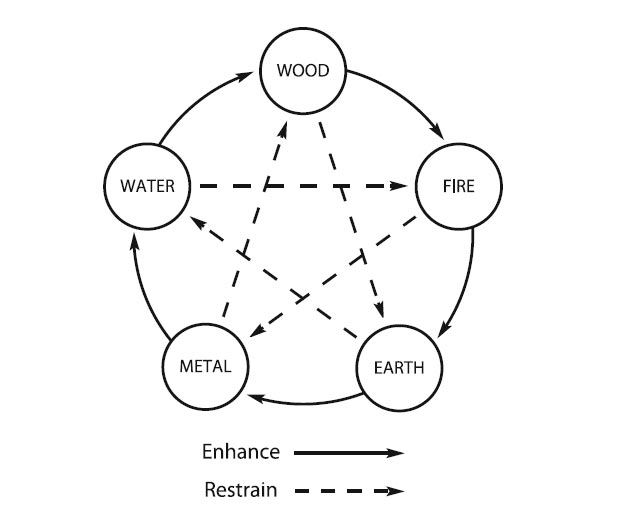Recently, a Ukraine student asked me the following question. “Since tea is a Wood element and there are many different kinds of tea such as, green tea, black tea, Oolong tea, Pu-er tea, etc., can each tea be classified into different elements in the Five-Element theory?” It took a moment for me to absorb the question and then I did not know where to begin to address his question.
For years I have encountered many questions regarding the application of the Five-Element theory. Most people, who have asked questions regarding this theory, do not have a clear grasp of its principles. This is truly understandable, as many feng shui books that mention the Five-Element theory do so only as a window dressing for the book. It seems to be standard practice to mention some form of both the Yin-Yang and Five-Element theories; however, it is rare to find a book that discusses the relevance and application of these theories in real terms. No wonder there are many who are confused!
So what is the Wu-Xing theory? Let’s try to break it down so we can have a better understanding of the principles behind the theory. In an earlier blog we talked about the Yin-Yang theory. The ancient Chinese used the Yin-Yang theory to describe the existence of all things and phenomena in the universe. From this we understand that there are four aspects of the Yin-Yang theory.
1. Yin and Yang unify and oppose
2. Yin and Yang entail each other
3. Yin and Yang increase and decrease
4. Yin and Yang transform into each other
Through these principles, we try to achieve balance and harmony.
So how does this relate to the Wu-Xing theory? To compliment this, they used the Wu-Xing theory to describe the dynamic transformation in the universe. Wu means five, Xing means passages. So, the Wu-Xing, or five-passages, represents a type of function that represents a form of change, a transformation of the characteristics that connect and interact with all thing in the world of time and space.
So, the key word here is interaction. This is a very important point to remembered. These interactions are transformed through three fundamental processes which affect their relationships and energy.
They are
1. enhancement
2. restriction
3. resonance

This differs from the Greek and Indian system as it relates more to the interactions between the elements as opposed to their individual characteristics.
In the Western world, Jesuits first rendered ‘Wu-Xing’ as ‘Five-Elements’, obviously having in mind the Four Elements of ancient Greek philosophers. This translation became very popular and is adopted by Needham in his renowned book ‘Science and Civilization in China’.
Unfortunately, that planted the seed of confusion and misunderstanding, causing people to associate the Five-Elements as just material elements. It left out the main point! As we discussed earlier, it is the interaction or relationship of the elements that should have been emphasized, not the motionless ‘fundamental’ substances. So, this belief has created many to stretch this misunderstanding in its application.
Nowadays we often come across a feng shui analysis of a table using the Five- Element theory. The following is an example of such a scenario. “This is a good table since it has all five elements; the form is square (Earth element), it is made of wood (Wood element), the color is red (Fire element) has metal legs (Metal element), and there is a wave-like (Water element) motif on the table…”
Not only is this kind of stretch rather comical, but there is no relevance with the quality of design either. However, today it is common to find many books using this type of stretch claiming they are following Wu-Xing principles. And they truly believe this is correct, because this is what they have been taught. So really it is no fault of theirs.
However, it is a shame that the true theories are not fully understood. The Wu-Xing theory is not easy to grasp at one session. It takes time to absorb, digest and comprehend all the aspects of its principles. For those that have taken the Wu-Xing class at Blue Mountain institute and are not yet confident in its understanding, it is always good to go back over your notes and to once again come to class to build on your ever expanding knowledge.

